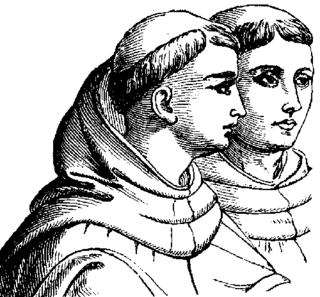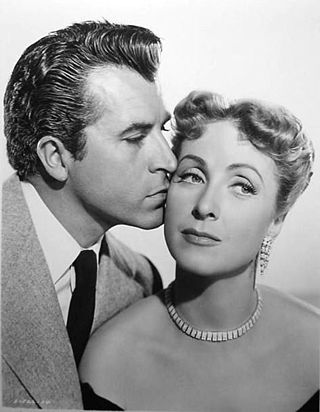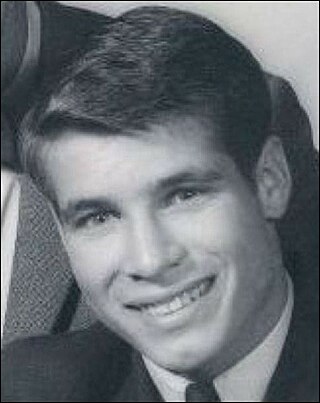
A hairstyle, hairdo, haircut, or coiffure refers to the styling of hair, usually on the human head but sometimes on the face or body. The fashioning of hair can be considered an aspect of personal grooming, fashion, and cosmetics, although practical, cultural, and popular considerations also influence some hairstyles.

Tonsure is the practice of cutting or shaving some or all of the hair on the scalp as a sign of religious devotion or humility. The term originates from the Latin word tonsura and referred to a specific practice in medieval Catholicism, abandoned by papal order in 1972. Tonsure can also refer to the secular practice of shaving all or part of the scalp to show support or sympathy, or to designate mourning. Current usage more generally refers to cutting or shaving for monks, devotees, or mystics of any religion as a symbol of their renunciation of worldly fashion and esteem.

A buzz cut, or wiffle cut, is a variety of short hairstyles, especially where the length of hair is the same on all parts of the head. Rising to prominence initially with the advent of manual hair clippers, buzz cuts became increasingly popular in places where strict grooming conventions applied. In several nations, buzz cuts are often given to new recruits in the armed forces or newly incarcerated inmates. However, buzz cuts are also used for stylistic reasons.

A ponytail is a hairstyle in which some, most, or all of the hair on the head is pulled away from the face, gathered and secured at the back of the head with a hair tie, clip, or other similar accessory and allowed to hang freely from that point. It gets its name from its resemblance to the tail of a pony.

The quiff is a hairstyle that combines the 1950s pompadour hairstyle, the 1950s flattop, and sometimes a mohawk. It was born as a post-war reaction to the short and strict haircuts for men. The hairstyle was a staple in the British Teddy Boy movement, but became popular again in Europe in the early 1980s and experienced a resurgence in popularity during the 1990s.

A crew cut is a type of haircut in which the upright hair on the top of the head is cut relatively short, graduated in length from the longest hair that forms a short pomp (pompadour) at the front hairline to the shortest at the back of the crown so that in side profile, the outline of the top hair approaches the horizontal. Relative to the front view, and to varying degrees, the outline of the top hair can be arched or flattened at the short pomp front and rounded or flattened over the rest of the top to complement the front hairline, head shape, face shape and facial features. The hair on the sides and back of the head is usually tapered short, semi-short, or medium.

The mohawk is a hairstyle in which, in the most common variety, both sides of the head are shaven, leaving a strip of noticeably longer hair in the center. Mohawk hairstyles have existed for thousands of years. As of the 21st century, they are most commonly associated with punks, or broader non-conformity.

A flattop is a classic hairstyle characterized by short hair on the sides and back of the head, with the top hair cut short and styled to stand upright in a flat, level plane.

Hi-top fade is a haircut where hair on the sides is cut off or kept very short while hair on the top of the head is grown long.

An induction cut, also referred to as a mighty fine, is the shortest possible hairstyle without shaving the head with a razor. The style is so named as it is traditionally the first haircut given to new male recruits during initial entry into many of the world's armed forces, but most particularly in the United States.

A lock of hair is a piece or pieces of human hair that are usually bunched or tied together in some way. A lock of hair can be on a person's head, or have been cut from the head. When attached to the head, a lock of hair generally refers to a tress, curl, or ringlet of hair. When cut from the head, a lock of hair may be kept for its symbolic value.

The temple fade, also known as a Brooklyn fade, taper fade, and blowout, is a haircut that first gained popularity in the late 90s and early 2000s in African American, Italian American, and Hispanic American barbershops as a variation of the bald fade, originating primarily in the Northeastern United States, particularly in New York City and especially Brooklyn.

Short hair refers to any haircut with little length. It may vary from above the ears to below the chin. If a man's hair reaches the chin, it may not be considered short. For a woman, however, short varies from close-cropped to just above the shoulders. This varies from culture to culture, in more traditional societies in Eastern Europe, Asia, and the Islamic world, short hair on women means anything shorter than chest length with chest length to elbow length being considered medium-length. However, among more progressive societies with far less structured gender norms, the classic bob is considered medium-length with "short hair" referring to pixie cuts and similar hairstyles. Different styles of short hair include the bob cut, the crop and the pixie cut.

A brush cut is a type of haircut in which the hair on the top of the head is cut short in every dimension. The top and the upper portion of the back and sides are cut the same length, generally between 1⁄4 and 1⁄2 inch, following the contour of the head. The hair below the upper portion of the sides and back of the head is tapered short or semi-short with a clipper, in the same manner as a crew cut. A variant form may have a slight graduation of the top hair longer from back to front or a quickly graduated bit of hair at the front hairline to achieve a little flip up of the hair at the forehead. A brush that is cut at less than 1⁄4 inch on top may be referred to as a burr. A brush that is cut at 1⁄4 inch or longer on top, and especially one that shows natural curl, depending on length, may be referred to as a short brush cut or brush cut. Brush cuts are traditionally groomed with hair control wax, commonly referred to as brush wax.
The undercut is a hairstyle that was fashionable from the 1910s to the 1940s, predominantly among men, and saw a steadily growing revival in the 1980s before becoming fully fashionable again in the 2010s. Typically, the hair on the top of the head is long and is often parted on either the side or center, while the back and sides are buzzed very shorter or shaved. It is closely related to the curtained hair of the mid-to-late 1990s, although those with undercuts during the 2010s tended to slick back and top gelled up the bangs away from the face.

Hairstyles in the 1980s included the mullet, tall mohawk hairstyles, jheri curls, flattops, and hi-top fades, which became popular styles. Amongst women, large hair-dos, puffed-up styles, permanent waves, and softer cuts typified the decade. Big hair that was "often permed to achieve the desired volume" is especially associated with women of the mid 1980s as well as male rockstars of that era, especially of the glam metal genre. Television shows such as Dynasty helped popularize the high volume bouffant and glamorous image associated with it.

An Ivy League, also known as a Harvard Clip or Princeton, is a type of crew cut in which the hair on the top front of the head is long enough to style with a side part, while the crown of the head is cut short. The length of the top hair and the degree of graduation shorter, from the front hairline back, varies with the shape of the skull, density and coarseness of the hair, and the styling preferences of the individual: side-parted crew cut, standard crew cut, brushed forward, etc.

In the Western world, the 1950s were a decade known for experimentation with new styles and culture. Following World War II and the austerity years of the post-war period, the 1950s were a time of comparative prosperity, which influenced fashion and the concept of glamour. Hairstylists invented new hairstyles for wealthy patrons. Influential hairstylists of the period include Sydney Guilaroff, Alexandre of Paris and Raymond Bessone, who took French hair fashion to Hollywood, New York and London, popularising the pickle cut, the pixie cut and bouffant hairstyles.

A regularhaircut in Western fashion is a men's and boys' hairstyle featuring hair long enough to comb on top, with a defined or deconstructed side part, and back and sides that vary in length from short, semi-short, medium, long, to extra long. The style is also known by other names including taper cut, regular taper cut, side-part and standard haircut; as well as short back and sides, business-man cut and professional cut, subject to varying national, regional, and local interpretations of the specific taper for the back and sides.
Secular laws regulating hairstyles exist in various countries and institutions.



















